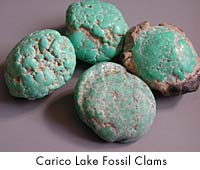 CANDELARIA
CANDELARIA
Candelaria turquoise was mined in an area not
too far from Tonopah, Nevada in the Candelaria
Hills. There is little reference to Candelaria
turquoise in the mining literature. The turquoise
in this area was usually found in thin veins
and is known for its beautiful almost electric
blues sometimes with a light matrix. Some of
the material rivaled the bright Blue Gem turquoise
that was used in inlay and Navajo jewelry. Turquoise
has been produced in the Candelaria area very
sporadically over the years. It was mined along
with the silver and gold ore that made Candelaria
mining famous at one point in Nevada's history.
Mining operations were originally established
in 1863 and began being worked heavily by the
early 1870's. At that time Candelaria was one
of the toughest camps in the West and a terrible
place to live, with its high temperatures, high
winds and no law enforcement.
With the areas low production of turquoise,
Candelaria became known more for its fine variscite
which is still available. Over the last few
years Candelaria turquoise has been seen again
in today's turquoise market. Along with a bright
blue material a beautiful dark blue turquoise
with red spider web has appeared from older
collections and has now been cut and is appearing
in fine jewelry. Candelaria is again having
its day, with beautiful spider webbed variscite
and a wonderful dark blue red webbed turquoise.
 back to top
back to top
 CARICO LAKE
CARICO LAKE
 The
Carico Lake mine is in Lander County, Nevada.
The name comes from its location a few miles
west of the dried up Carico Lake bed. Turquoise
coming from the mine ranges from light green
to a medium blue with a matrix of mostly limonite.
Turquoise from this district has earlier been
sold as Aurora and Stone Cabin turquoise. These
mines had been run by August Stenich and later
by J.W. Edgar, both legends in Nevada turquoise
mining. Although today the Carico Lake mine
is one of the larger producing mines in Nevada,
high-grade turquoise from this mine is still
fairly uncommon. The
Carico Lake mine is in Lander County, Nevada.
The name comes from its location a few miles
west of the dried up Carico Lake bed. Turquoise
coming from the mine ranges from light green
to a medium blue with a matrix of mostly limonite.
Turquoise from this district has earlier been
sold as Aurora and Stone Cabin turquoise. These
mines had been run by August Stenich and later
by J.W. Edgar, both legends in Nevada turquoise
mining. Although today the Carico Lake mine
is one of the larger producing mines in Nevada,
high-grade turquoise from this mine is still
fairly uncommon.
Carico Lake is now famous for its bright greens
known as "faustite." This material
with its high zinc content is a bright apple
green color sometimes with golden webbing and
has been highly valued because of its beauty
when set in gold. Carico Lake turquoise has
also become known for its rare and beautiful
"fossil" turquoise clams. Clam fossils
in the dried up lakebed were dissolved away
and the cavities left were filled with turquoise
deposits in the shape of the clams, leaving
what has been called Carico Lake "fossil"
calms.
|